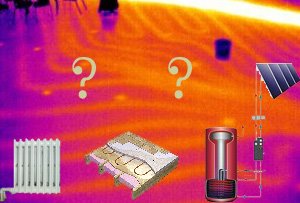 Not many second hand flats in Barcelona have central heating so instead people use very energy intensive electric heaters or bottled gas heaters (not without danger). We thought since we have to do the whole flat up we might as well use the opportunity to put in a radiant floor.
Not many second hand flats in Barcelona have central heating so instead people use very energy intensive electric heaters or bottled gas heaters (not without danger). We thought since we have to do the whole flat up we might as well use the opportunity to put in a radiant floor.Why? –Because underfloor heating is supposed to be the most comfortable and eco-efficient form of heating. This is because it heats up the rooms evenly from the bottom to the top (since heat rises) instead of localised heating through radiators that need to produce a lot of heat in order to keep the other side of the room hot too. Plus no heat is lost through ducts. It’s also healthier they say, since it doesn’t dry out the air as much and heats up your feet and hands first (warm hands and feet, cool head). Another big advantage is that it is totally silent and non-obtrusive. It saves you a lot of space and you won’t have to worry about the aesthetics of any radiators. Eco-friendly material is also available such as a cork base (local and fast renewable) and PVC-free tubes (hence recyclable) to conduct the hot water.
Now this all sounds great but after a reality and wallet check it doesn’t seem too efficient anymore since the cost of installing a radiant floor is not worth what you save on energy and in our case it demands some massive construction work. The only possible exception is a water heating system (other types are air-heated and electric radiant floors) used in conjunction with solar heating.
Now we are in Spain so solar heating sounds obvious, doesn’t it? Think again! First you need permission to decorate the roof of the building (which normally is communal and used for sunbathing and laundry drying) with the solar installation (and some people don’t like the look of those). Second, the solar heater needs somewhere to store the hot water and where do you put a big black 2m high and ø1m water deposit in a 55m2 flat?
An alternative to solar heating is one of those new efficient gas heaters that heat the water for the floor and for the rest of the house. But that still leaves us with the actual radiant floor installation whose cork base and water tubes are normally covered with concrete. Now that is a hell of a lot of added weight for an old building like ours which means the old floor would need to go. And that means 2 weeks of picking the floor (and screaming neighbours) as well as getting rid of the rubble by carrying it 3 floors down (! no lift in that part of antic Barcelona). We’d also have to check with an engineer if we can take out the old floor (who knows what’s underneath) and if it’s structurally safe to add a radiant floor to this old building.
Conclusion: So after having a clearer picture of what it would mean to install a radiant floor (money, risks, side effects, time, …) we started wondering if it’s worth it. After all we are in Barcelona where you’d use heating at most 4 months a year. The advantage would obviously be the fact that the rest of the year you don’t have to sit amongst use-less radiators but don’t they do small sexy ones nowadays? And if you operate them with that energy efficient gas heater (that reuses the heat of the gas flame to heat the water, …) until you convince the rest of the flat owners to invest into communal solar heaters? You could still make the whole thing PVC free, insulate the flat properly so no heat is wasted and have a timer on it for more efficient use. We’re still investigating on this but if you have any suggestions please let us know!
More information on radiant floors: EERE (US), Klaus (Spain), Self Build ABC (UK)

3 comments:
Hey guys! ¡Que buen idea! A blog for rebuilding your flat - I'd love to come over and do some pics for the website for ya... but I got my own flat to move into... too bad it doesn't need doing up, cos I'd follow your tips otherwise...
Adamski
Londres
Can you recommend someone to go to in Barcelona for advice on replacing an existing boiler as ecologically as possible? As you might expect, this is kind of urgent...
Hi! You could contact me (via my profile) if you want to talk, but just of the top of my head I would recommend a condensation boiler (caldera de condensación), assuming you are connected to the gas mains. These are a little more expensive but way more efficient which will keep your bills down. And then there is solar of course to heat your water!
Post a Comment